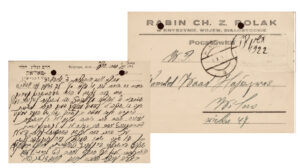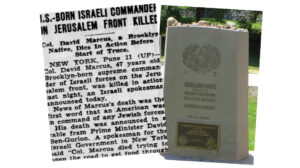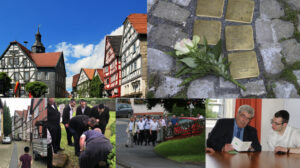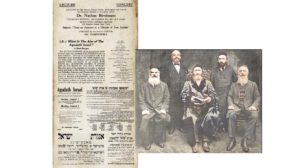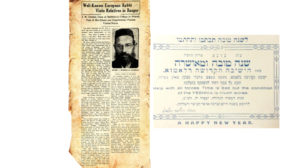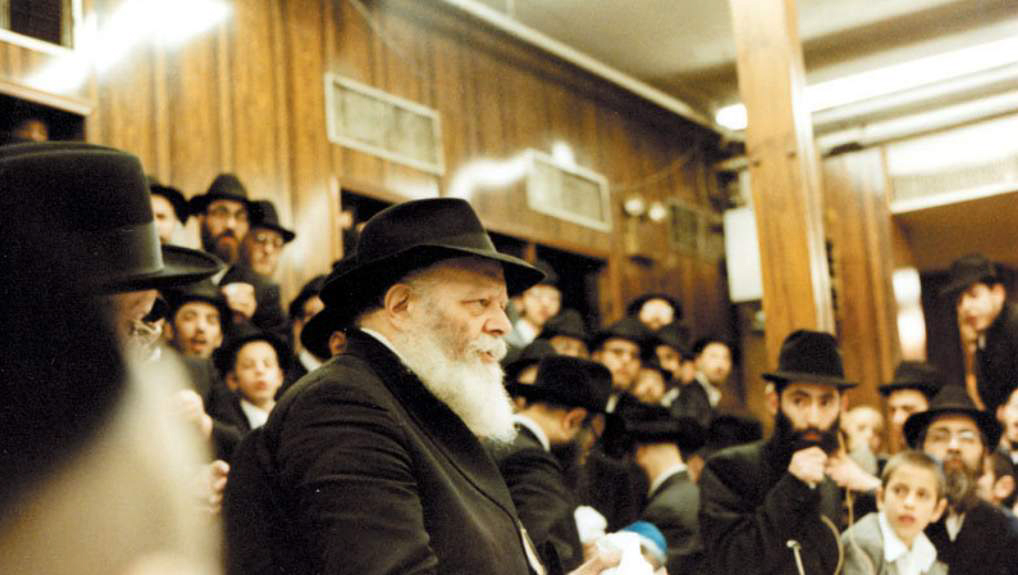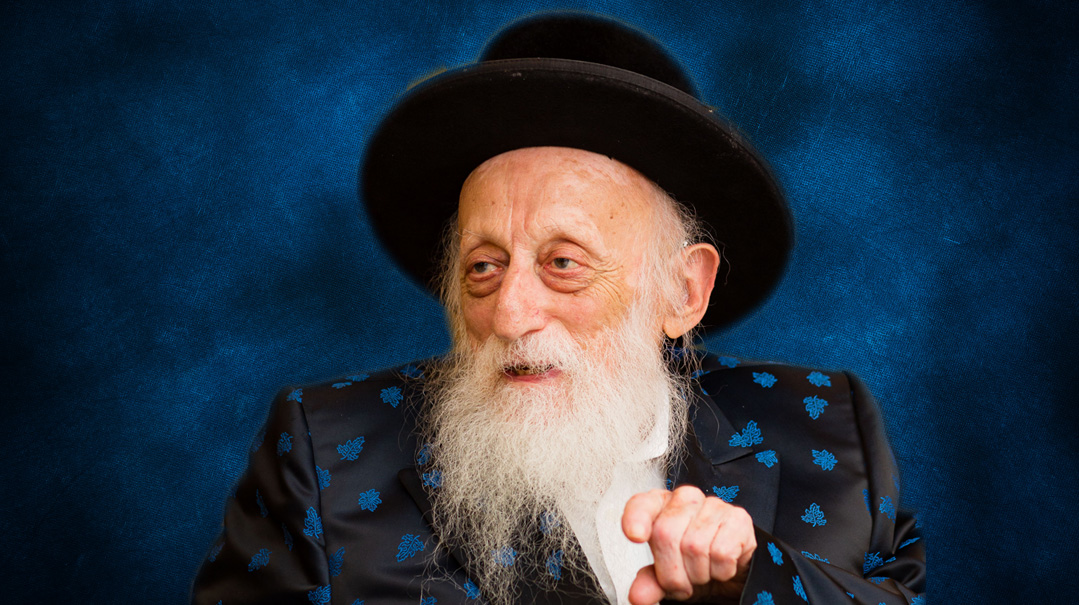Six Fateful Days


HAND OF G-D “We see chaos everywhere” he explained. “But now on one point on the globe we see justice asserting itself — in Eretz Yisrael. After 2 000 years of exile Jews are returning to their land.” That was enough proof for him that the Hand of G-d was at work behind the scenes (Photos: AP GPO)
T he Mishnah instructs us not to make our prayers “keva” or to recite them by rote lest we forget the special significance of every word. Such is the situation in Jerusalem today. We walk the streets with ease and confidence forgetting that at one time such a stroll would have been unimaginable.
In these days of easy access to our holy places it’s difficult to understand the mindset of a Jew in Jerusalem prior to June 1967. Let’s try.
He imagined that he would never touch the Kosel with his hands. He imagined that he would visit the Jewish Quarter one day — when Mashiach comes. Until that time he would scurry to a little corner in Armon Hanatziv where a vendor would rent him a pair of binoculars through which he could capture a glimpse of what once was.
And then even that precious little slice of holiness seemed endangered. In 1967 a massive military threat from an Arab coalition hung over the Jews of Israel. Rumblings of war emanated from three fronts: Egypt Jordan and Syria. Israel’s municipal authorities designated the parks as cemeteries so certain were they of mass casualties. There would be mountains of bodies and the Holocaust survivors among Am Yisrael warned of the coming slaughter.
And then in Reb Chaim Shmuelevitz’s words Hashem reestablished His throne of old and the Jewish people could once again pray at Heaven’s gate.
It has been so many years since 1967 — beyond many of our lifetimes — that it is simply impossible to imagine the immensity of the turnabout that took place 50 years ago. Fortunately we have many witnesses talented writers who can transport us back to that time and place.
The Rebbe’s Promise
Rabbi Tzvi Hersh Weinreb former head of the Orthodox Union and a popular speaker and writer was a young rabbi living in Brooklyn when war broke out in in 1967. Here he describes his encounter with Rav Shmuel Eliyahu Taub soon after the war.
My memories of 28 Iyar 5727 fall into two distinct categories. The first is based upon my own personal experiences during that fateful week while I was living in the safety of Brooklyn New York. The second is based upon our experiences during a visit that my wife Chavi and I paid to Israel several months later during the holiday of Succos.
We were living in Brooklyn during the Six-Day War. Along with the rest of the Jewish people we felt the anxieties that preceded the war itself. We followed the news and viewed and heard the speeches of the leaders of the Arab world threatening the destruction of the State of Israel and the annihilation of the inhabitants of our Holy Land. Those speeches were no less horrifying than the films we had seen of Adolf Hitler at his most vile moments. Whereas Jews who heard Hitler in the 1930s may have doubted that he would carry through upon his threats by 1967 we had tragically learned to take such threats very seriously.

“Today the Shechinah hovers over all of Israel in shelters and behind sandbagged windows”
The instant we heard the news of the outbreak of actual war I was filled with fear and panic. The television carried footage of workmen digging thousands of graves in the parks and open fields of major cities in Israel. The most optimistic prediction was of a long and protracted battle with numerous military and civilian casualties. I had dozens of family members and personal friends living in Israel at the time and I was haunted by unspeakably dark images of their fate. I slept little and hardly ate during those scary days.
Then suddenly the news came in first of the destruction of the Egyptian Air Force then of all the military successes and finally the dramatic voices announcing the recapture of the Old City of Jerusalem the fact that the Har Habayis was in our hands and the unbelievable pictures of Israeli soldiers praying and weeping at the Kosel. With that news and those images came feelings of relief of exhilaration and finally the conviction that all of this was literally a miracle a fulfillment of Divine prophecies. (Excerpted from Mishpacha Issue 661)
When My World Stood Still
Mishpacha columnist author and speaker Yonoson Rosenblum was a 15-year-old high school student in suburban Chicago when war broke out halfway around the globe. But the battle couldn’t have felt closer.
Rav Yaakov Kamenetsky once said at an Agudath Israel of America convention that but for the creation of Israel in 1948 most of non-Orthodox American Jewry would have lost all Jewish identity and connection to the Jewish people. The Six-Day War played a similar role for my generation born after 1948.
During the tense three weeks leading up to the Six-Day War all normal rules were thrown out the window in my house. A TV had never entered our dining room or the adjacent living room. But during that period the entire family sat glued to the TV set at dinner. No one spoke as we listened to Abba Eban’s mellifluous oratory at the United Nations.
On the morning of June 5 my mother came into my room to awaken me. She was crying. The explanation followed immediately: “Israel is at war.” Though it was already well into the afternoon in Israel and the Egyptian Air Force lay a smoldering wreck on tarmacs across Egypt I knew none of that as I headed for high school just a half block from my house. The initial reports were not good and the Egyptians’ hysterical crowing of historic victory dominated the early news. (Jordan’s King Hussein was misled by the same lies coming from Cairo leading him to the ill-fated decision to join the attack on Israel.)
That day as I walked through the familiar high school corridors there was nothing visibly different. And that was what struck me. My high school was about half Jewish and much more heavily so in the upper-track classes. But as I moved from class to class everyone seemed to be going about their business as usual.
Of course one does not know what is going on in anyone else’s head. But I saw none of the panic that I felt. No sense that the entire world held in the balance and that a second Holocaust might be unfolding before our eyes. That afternoon I asked the driver’s education instructor to turn on the radio of the car in which I and two other classmates were practicing on the local roads. His bull neck (he was also the wresting coach) tensed at the request and he turned around to look at me as if I had lost my mind which in some way I had. (Excerpted from Mishpacha Issue 661)
Hills Filled with Song
Rebbetzin Miriam Krohn was a seminary student in Jerusalem when Israel was plunged into war.
When I left Denver in the fall of 1966 to study in Israel it never occurred to me that I would participate in one of the most historic and cataclysmic years in all of Jewish history.
Has it really been 50 years since my parents sent that telegram frantically urging me to leave Eretz Yisrael as the war approached? Has it really been 50 years since I volunteered at Shaare Zedek Hospital? Has it really been 50 years since we all walked to the Kosel that Shavuos morning and davened and cried as we never had before?
Let me share with you some of the trepidation the excitement and the jubilation of those incredible days.
Everyone who was there both residents and visitors can recollect where they were when the war broke out. I was a seminary student in Yerushalayim. At the time it was a rarity to learn in Israel a privilege not to be taken for granted. But by May politics had encroached on our learning. The Arabs were threatening war and the Israelis were promising a strong defense and an even stronger offense. Soon it was impossible to ignore the signs. Shoppers emptied shelves in the supermarket; the seminary put us through drills so we’d know where to go and what to do should the worst come about. Tension was in the air and we were not immune to it.
In those days long-distance calls had to be reserved by appointment at the post office. When I finally spoke to my father he insisted that I book a flight out immediately. I tried to convince my parents that I was safe where I was but they wouldn’t budge. But within a few days there was no choice: Flights were no longer leaving Israel.
Militarily Eretz Yisrael stood alone. But we were never really alone. The siyata d’Shmaya that we counted on and the Tehillim that we said nonstop by candlelight in the miklat were our constant companions.
The attack began on the morning of 26 Iyar June 5 a bright and “ordinary” Monday. We were instructed to take our siddurim pack our basic needs and make our way to the bomb shelters. We were lucky in our school: The entire basement of the building was considered a safe zone.
We had running water electricity and refrigerators. We slept in sleeping bags on thin mattresses. At the time civil-defense sirens rang out regularly and it was common to see people running from place to place in search of shelter. Soldiers were being called up in frightening numbers. The fear was palpable. Every person asked himself not only what he could do but what he should do. I was no different.
For me it was all surreal. As an American I had never experienced war. I had heard about the war years from my parents and my friends’ parents but I had never actually been close to one. But if they survived I prayed I would too. What was at stake was obvious: This was an existential war on Israel and the Jewish people.
Still classes went on teachers came and went and testing continued. The oral exam on Yedias Ha’aretz took on a new significance. The map itself was changing even as we studied it. (Excerpted from Mishpacha Issue 661)
Turnabout in Brazil
Mishpacha editor-in-chief Rabbi Moshe Grylak was working in Jewish outreach in Brazil when war broke out in 1967. In that country far from home he experienced the astonishing admiration of the non-Jewish world for Israel.
On the day the Old City of Jerusalem was liberated I was living temporarily abroad in Sao Paulo Brazil. And in that foreign land I experienced one of the most wonderful days of my life.
I was there to run a religious and educational program sponsored by the Jewish Agency. My family and I had been in that wealthy pampered Jewish community for a year so the war caught us off guard far from home and our relatives back in Israel. Cell phones and e-mail were still decades away and at that time even landline phones were a luxury in Israel — and our parents weren’t among those who had them. We kept in touch only by letters which traveled at the speed of a sea snail.
So you can imagine how we felt when we heard the news of war brewing in Israel and how anxiously we followed the daily reports in the local media. Egypt’s army we heard had entered Sinai and was encamped at Israel’s border preparing to attack. To make matters worse the Brazilian press was regurgitating propaganda from the Arab nations who were promising victory on the battlefield.
Of course all of this turned out to be empty boasting but we had no way of knowing that; Israel was playing its military cards close to its chest. Our fears were only heightened when Israel’s finance minister Pinchas Sapir showed up in person to collect donations from the Jews of Sao Paulo for the war effort. In a private meeting with the various shlichim of Israel and the Jewish Agency he told us that large parks back home had been designated as cemeteries; massive casualties were expected. Naturally our spirits plummeted and we stepped up the intensity of our prayers.
And then after three nerve-wracking weeks war broke out. In the papers and on the radio and television Arab sources claimed victories on every front. But on the Israeli side there was silence. “Fog of war ” they called it. We were left in the dark close to despair fearing the worst — that we might have nothing to return to chalilah. (Excerpted from Mishpacha Issue 661)
In the Line of Fire
American-born Nachum Pessin was the administrator of Shaare Zedek Medical Center during the Six Day War. He was appointed its official army liaison for the duration of the war and together with the staff spent the entire six days in the hospital offering medical care and support to wounded soldiers and civilians. He retired as associate director general in 2010 after serving the hospital for 45 years.
I was your typical Orthodox American Jew: born and bred on the Lower East Side graduate of RJJ and Yeshiva University degree in accounting and business management. But I always had this desire to move to Israel.
I worked for two years to save up money for my aliyah then came to Israel in 1961 ahead of my wife and children to look for a job and place to stay.
I found a job as director of Yeshivat Netiv Meir a Bnei Akiva yeshivah high school —one of the first in the country. Then I found a little apartment in Jerusalem’s Bayit Vegan neighborhood. Everything was set; now my wife and children could join me. (When my mother-in-law paid us a visit she said “This is not an apartment it’s a garage. No one lives like this anymore!” But to us it was very nice — anything in Israel was nice.)
In 1965 I was hired as administrator of Shaare Zedek hospital. At the time the hospital was located on Jaffa Road and had 190 beds and maybe 250 to 300 nurses — but we were the second to largest hospital in Jerusalem. You have to remember there were just around 200 000 Jews living in the city at the time. Little did I know when I took that job that our little hospital would play a role in a historic war.
In May 1967 everyone was watching the news. As soon as the Egyptians closed the Sinai passage and the UN moved its people out we knew with certainty that war was coming. My parents sent me a cable with the instruction: “Send the children.” There was no way in the world would we do that. I sent them back these words: “Lo Yanum V’Lo Yishan Shomer Yisrael; the Guardian of Israel neither slumbers nor sleeps.” (Later I learned that my father was so proud he showed that telegram to everybody.)
Until that point Shaare Zedek functioned as a private hospital collaborating with the army only on emergency protocol. But now the army came down for a meeting and requested the appointment of an official army liaison. That’s how I became a mefaked an army commander — though I never served a day in the IDF and never received a uniform or rank. My new responsibilities included ramping up the hospital to a wartime level of preparedness. A large number of wounded soldiers were expected. The army also determined which hospitals would receive which type of civilian emergencies during the war.
We had to set in place a system whereby the military could receive constant updates on hospital resources such as available beds critical care units and operating facilities. They would also need frequent updates on the condition and number of soldiers we had received. Communication was paramount. (Excerpted from Mishpacha Issue 661)
The 2000-Year Wait
In 1967 Rabbi Emanuel Feldman spent a sabbatical year teaching at Bar-Ilan University. He decided to keep a diary when war broke out in June which eventually became a book The 28th of Iyar. Here in an excerpt from the book he describes visiting the Kosel for the first time and a surprise reunion with one of his students.
FRIDAY 1 SIVAN JUNE 9: This morning is the morning. Together with the foreign correspondents I visit the Ir Ha’atikah — the Old City of Jerusalem. That slides off the pen so easily: I visit the Ir Ha’atikah. Best for now not to dwell on the unreality of it all and the choking anticipation as we drive toward the ancient city walls.
We walk through Damascus Gate and the narrow winding streets. From every window flutters a white flag. The Arabs crouching on their stoops eye us with a mixture of hostility and curiosity. We walk towards the Temple Mount and the gold-domed Mosque of Omar which is built right on the spot where the Holy of Holies of the Beis Hamikdash stood. (I will not try to describe my feelings.) Through a huge wooden gate down some steps and there it stands — stark and gray and brooding. The Kotel Hamaaravi the Western Wall the Wailing Wall the last vestige of the glory of ancient Israel.
How do you embrace a wall? I have seen its picture hundreds of times and dozens of paintings and sketches but my eyes have never looked upon it as they do now; I have read poems about it and short stories and novels but I have never placed my two hands upon it as I do now; I have studied ancient texts about it and seen what the Midrash and Chazal say about it but I have never touched my cheeks against the cool rough-hewn slabs of limestone as I do now. I want to weep but I cannot. I can only rest my forehead in its dark crevices and stare dumb and mute and silent.
Soldiers grimy and hot from battle are running up to it touching the huge blocks of stone caressing them prostrating themselves on the ground. They put on tallis and tefillin and with their guns on their shoulders and in full battle dress they pray and shout out the Shema — Hear O Israel Hashem is our God Hashem is One.
I notice that everyone takes a scrap of paper scribbles something on it and places it between the huge blocks. I do likewise and write on it the names of the entire family with a prayer for health.
The Shechinah G-d’s presence say Chazal hovers over the Wall. Today it hovers over all of Israel. We go on to visit Bethlehem only a few miles away. I ask the driver if we can stop at Rachel’s Tomb. It is late but he reluctantly agrees.
“Five-minute stop to visit Rachel’s Tomb ” he announces.
“I’ve waited 2 000 years and you give us five minutes ” I say. Everyone laughs. But I was not joking. (Excerpted from Mishpacha Issue 661)
Oops! We could not locate your form.

